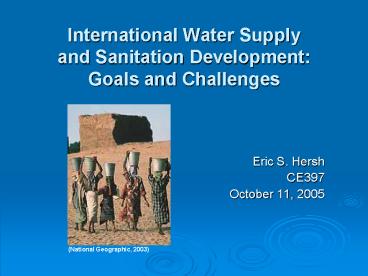International Water Supply and Sanitation Development: Goals and Challenges - PowerPoint PPT Presentation
1 / 20
Title:
International Water Supply and Sanitation Development: Goals and Challenges
Description:
'Reduce by half the proportion of people without sustainable ... untied aid (Water for People, 2004) (Kenya Water for Health Organization, 2004) MDG progress ... – PowerPoint PPT presentation
Number of Views:78
Avg rating:3.0/5.0
Title: International Water Supply and Sanitation Development: Goals and Challenges
1
International Water Supply and Sanitation
Development Goals and Challenges
- Eric S. Hersh
- CE397
- October 11, 2005
(National Geographic, 2003)
2
the challenge
- 2000 world population 6.1 billion
- Water Supply Sanitation
(81)
(57)
without access, in billions
(WHO, 2000)
3
UN Millennium Assembly
- September 2000, New York
(B.Liu, Princeton, 2004)
4
Millennium Development Goals
- 1. poverty and hunger
- 2. primary education
- 3. gender equality
- 4. child mortality
- 5. maternal health
- 6. HIV/AIDS, malaria, diseases
- 7. environmental sustainability
- 8. development partnerships
5
Goal 7, Target 10
- Reduce by half the proportion of people without
sustainable access to safe drinking water - (UN MDGs)
- and basic sanitation.
- (WSSD, Johannesburg, 2002)
6
WSS as a precondition
- 1. poverty and hunger
- 2. primary education
- 3. gender equality
- 4. child mortality
- 5. maternal health
- 6. HIV/AIDS, malaria, diseases
- 7. environmental sustainability
- 8. development partnerships
7
some definitions
- sustainable access to safe drinking water
- lack of WQ data to define safe
- indicator reasonable access to an improved
source - sustainable access to improved sanitation
8
some definitions
- sustainable access to safe drinking water
- lack of WQ data to define safe
- indicator reasonable access to an improved
source - sustainable access to improved sanitation
(AusAID)
9
what does it take?
- Official Development Assistance
- 0.7 GNP (magic number)
- 1970 UN General Assembly, 2002 Monterrey, 2002
WSSD - implementation
- education
- pro-poor entities
10
a thought experiment
by Jeffrey Sachs, PhD
- extreme poverty lt 1/day
- in 2001, 1.1 billion people
- 113 per capita per year below 124 billion
- 0.6 of GDP
- World Bank revision 25 billion
- 2001 aid 46 billion
11
why not?
If action were measured in words rather than
dollars, then the problems of development finance
would have been solved long ago. -UN University
World Institute for Development Economics
Research, 2005
12
0.16
0.25
(OECD, 2005)
13
cost of MDGs
UN Millennium Project, 2005
2006 135 billion 0.44
2015 195 billion 0.54
2004 80 billion 0.25
- WSS 100 billion for 2001-2015
- 6.7 billion per year
14
MDG challenges
- population growth
- absorptive capacity of least developed countries
- pro-poor entities
- debt and disaster relief
- tied aid
- rural and urban slum populations
15
traditional water supply and sanitation challenges
- high capital investment
- long payback period
- low rate of return
- foreign exchange risk
- non-transferable assets
(CU Denver, 2000)
- financial and technical capacity of responsible
agency - regulatory and political uncertainty
16
new paradigm
- capacity-building
- community involvement and ownership
- education
- untied aid
(Water for People, 2004)
(Kenya Water for Health Organization, 2004)
17
MDG progress
- water supply
- 1990 to 2002 77 to 83
- India, 1990 to 2002 68 to 86
- sanitation
- 1990 to 2002 55 to 58
- ODA
- 0.23 in 2002, 0.25 in 2004
- 16 countries pledged to meet 0.7 by 2015
- 32 tied in 1990, 8 tied in 2003
(WHO/UNICEF, OECD, 2005)
18
MDG progress, 2005
(UN, September 2005)
19
MDG outlook
- With the exception of sub-Saharan Africa, the
- world is well on its way to meeting the drinking
- water target by 2015
- but progress in sanitation is stalled in many
developing regions. - -WHO/UNICEF Joint Monitoring
- Programme on Water Supply
- and Sanitation, 2004
20
questions for discussion
- Are the MDGs realistic and practical? Is an
increase in Official Development Assistance to
0.7 simply the answer to meeting them? - For the current case of limited ODA, should water
supply and sanitation be priorities? Does the
return, as measured in improvements to the human
condition, benefits to the receiving nation, or
financial return to the donor(s) justify the
expenditure? - Are you willing to pay 70 cents on every 100
dollars you earn per year to eradicate extreme
poverty and improve the human condition
worldwide?































